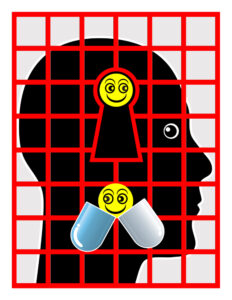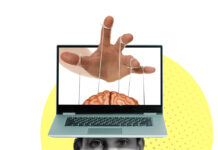A new study, published in Frontiers in Psychiatry, examined public attitudes toward psychiatric coercion across varying contexts. The results suggest that public support for coercion in psychiatric care increases when individuals in crisis display signs that are perceived as dangerous. Alternatively, when there is a high degree of familiarity with psychiatric treatment, people tend to show less approval for coercive treatment.
These results highlight how stigmatization plays a central role in maintaining coercive practices in mental health care. If stigmatization leads to the approval of more severe and coercive restraint measures, then preventative interventions to reduce coercive practices should include popular education programs targeting the reduction of bias towards individuals with several mental health issues.
“Approval of coercion might be a negative consequence to people with mental illnesses as a result of labeling dangerousness to them. However, the association of stigmatization of persons with mental illness and the approval of coercion is currently under-researched.,” wrote the authors, led by Christian G. Huber, a researcher at the University Psychiatric Clinics Basel in the University of Basel.
 The use of coercive psychiatric practices has received increased attention in research and among advocates internationally. In a recent report, the WHO has called for “considerable” changes in the use of forced admission and treatment due to increasing reports of unsafe conditions in psychiatric treatment. Another report published in Epidemiology and Psychiatric Sciences shows that coercive practices lack empirical support and violate human rights.
The use of coercive psychiatric practices has received increased attention in research and among advocates internationally. In a recent report, the WHO has called for “considerable” changes in the use of forced admission and treatment due to increasing reports of unsafe conditions in psychiatric treatment. Another report published in Epidemiology and Psychiatric Sciences shows that coercive practices lack empirical support and violate human rights.
There is increasing evidence that coercive practices result in negative health outcomes. For example, a past study shows that physical restraints are associated with dehumanization, loss of self-determination, and mistreatment.
Qualitative examinations of coercion and dehumanization in mental healthcare also show that individuals who are involuntarily committed tend to navigate complex experiences around autonomy, primarily in needing to decide whether to accept institutional structures and language or resist them. Additionally, there is an added layer of oppression in the use of coercive practices when multiply-marginalized individuals are involved— an example of this intersectional discrimination is seen in the experiences of African refugees and immigrants in Canada who tend to be at higher risk for psychiatric coercion than other marginalized communities.
Although coercive measures remain widely in their use, there is insufficient evidence for their short-term effectiveness in reducing danger. Moreover, many risks are associated with coercive practices, including negative emotions (i.e., fear, anger, shame, helplessness), traumatization, negative impacts on the therapeutic relationship, and poor adherence in therapy.
An equally important negative effect of coercive practices is a potential increase in stigmatization, which creates added barriers for individuals with mental health concerns, such as added discrimination and public stigma.
“Stigma is often described as a ‘second disease’ because the fear of rejection is perceived just as stressful as the condition itself,” the authors write.
The research team conducted quantitative analysis on a representative survey of Switzerland’s general population (n = 2,207). Participants received a vignette describing a person with externalized psychological symptoms and were asked to decide whether coercive measures were an acceptable approach for the individual.
Research participants were given three options in response to the vignette (involuntary hospitalization, involuntary medication, and seclusion) and asked to rate each approach on a 4-point Likert scale ranging from “agree strongly” to “disagree strongly.” In addition, other measures were included in the study, including the desire for social distance, perceived dangerousness, and familiarity with psychiatric treatment.
After conducting a logistic regression analysis examining approval of coercion regressed by contextual factors within the vignettes, the researchers found that approval for coercion in the general public tended to increase when fictitious characters in the vignettes displayed dangerous behavior or symptoms of a psychotic disorder, were perceived as dangerous, or when respondents perceived that coercive measures would benefit the character.
Results also showed that approval for coercive treatment decreased when respondents had a degree of familiarity with mental illness, either through first-hand experience with psychiatric treatment or through proximity to a loved one who has received psychiatric treatment.
This study provides evidence that stigmatization plays an influential role in the public perception of individuals with severe mental health concerns and the approval of coercive measures in the case of psychiatric crises.
“Reducing stigmatization and misconceptions about the dangerousness of persons with mental illness and increasing familiarity with psychiatric patients seem a vital and essential task for clinical psychiatry to further decrease coercive measures in the treatment of persons with mental disorders,” the authors write.
Huber and colleagues recommend that reducing stigma and increasing familiarity with mental illness in the general public is an integral consideration for psychiatry in decreasing coercive measures.
****
Steiger S, Moeller J, Sowislo JF, Lieb R, Lang UE and Huber CG (2022) Approval of Coercion in Psychiatry in Public Perception and the Role of Stigmatization. Frontiers in Psychiatry. 12:819573. DOI: 10.3389/fpsyt.2021.819573 (Link)















—Reducing stigmatization ??
Really? We have settled on “reducing” it, not rejecting it?
What possibly causes us to give up on rejecting it?
Harold A Maio
Report comment
“If stigmatization leads to the approval of more severe and coercive restraint measures, then preventative interventions to reduce coercive practices should include popular education programs targeting the reduction of bias towards individuals with several mental health issues.”
I agree, educating the public regarding the fact that the ADHD drugs and antidepressants can create the “bipolar” symptoms – thus educating the public that “bipolar” is an iatrogenic illness, created by psychiatrists for profit, not a “genetic” illness – might help the public fear those who’ve been stigmatized as “bipolar” less.
And since the antipsychotics can create “psychosis,” and other positive symptoms of “schizophrenia,” via anticholinergic toxidrome. Plus the antipsychotics / neuroleptics can also create the negative symptoms of “schizophrenia,” via neuroleptic induced deficit syndrome. Meaning “schizophrenia” is also an iatrogenic illness, created with the “gold standard schizophrenia treatments.”
Well, properly educating the public regarding the fact that the psychiatrists are actually creating “bipolar” and “schizophrenia” symptoms in their clients, with their psychiatric drugs. This might help the public garner insight into the reality that those stigmatized with serious “mental health issues” are people who made the mistake of believing the “trust your doctor” propaganda, who were duped by psychiatrists. This makes us “too trusting” individuals, but not “violent” individuals.
“Huber and colleagues recommend that reducing stigma and increasing familiarity with mental illness in the general public is an integral consideration for psychiatry in decreasing coercive measures.”
The problem is the psychiatric industry has no desire to confess that their psych drugs can create the symptoms of their “invalid” DSM disorders. Plus, it’s not profitable for the psychiatric industry to decrease coercive measures, so they don’t want to do that either.
But given the fact that the psych drugs can create the symptoms of the serious “mental illnesses.” It does make sense to – not just decrease coercive measures – but to end forced psychiatric treatment altogether.
After all, even the psychiatrists made a promise to “first do no harm.” Although I will say, Hippocrates would be appalled by today’s psychiatric industry’s hypocrisy.
Report comment
“Results also showed that approval for coercive treatment decreased when respondents had a degree of familiarity with mental illness, either through first-hand experience with psychiatric treatment or through proximity to a loved one who has received psychiatric treatment.” _ that is totally correct…!
Report comment
With the lack of outlets:
Having just put a wooden sailboat kit together, to see how it actually works as an a-bottle-boat when the flat side is down to rest on the rim, and the other side has a peg in it to keep it from pushing off of it [the rim of the bottle], and wondering what this has to do with a boat in a bottle (take out “in a”)….
People called “autistic” used to have all form of outlets. They could make boats in bottles, they could paint backwards from the mirror leaving it to be used properly in a creative manner rather than to coach Snow white how to please her man, they could add up how many stars makes magic, and why the sky gets dark at night, and they could save the little ones from fear of the dark, they could play with the horses outside and smell the grasses that held their stocks wound into baskets, they could remember what it was to feel the darkness of illness leave and the blossoming of each breath renewed with the smell of what blessing of nature’s that healed them, they could look at stones, knowing where they came from rather than have to answer stupid question like why the “chicken” crossed the road (is there a difference between gravel and feed?), which in these times is insulted would it not, then it would be a “chicken,” while bereaved of stating that would it, it wouldn’t be what its name is used for………
And thus we have antistigma, “roll call” for who if not present to take their “meds” gets to have the police pick them up, or have to deal with the government needing info about area of-the-number-of-states-minus-one……
Report comment
Mass Media, in particular, takes advantage of people’s fears in this and many areas. I think now they are trying to make the public feel guilty for the “stigma” associated with alleged mental illnesses that they (the public) have bought into. They have purposely kept it a “mystery.” They will say something such as this person has such and such and suffered and we don’t know quite why. Except there are some who publicly do say things like they do take psychiatric drugs because of their “biochemistry and genetic makeup.” The latter I heard from a therapist who spoke on a local tv newscast. The sad part is that those of us who have different experiences are usually not allowed to tell our story. This means that there is not a balance to these stories, therefore someone in a quandary about themselves or a loved one will not be able to make an accurate assessment as to what is best for themselves or their loved ones. In my odd opinion, perhaps, keeping some stigma associated with “alleged mental illnesses” might prevent some from seeking a psychiatrist, etc. and that could very well save lives (in so many ways.) The fact that there is a lack of true balanced information available to the public about psychiatry is very tragic for so many in these modern times. Thank you
Report comment
Since “A Spoon full of Sugar,” thanks To Julie Andrews squealing around like the mice that Jesus supposedly couldn’t take care of as the Pied Piper, being a joke not passed: “So a man ran over a cat, and told the owner, who when offered by him to replace it asked whether he was good at catching mice…..”
I won’t indulge in the recipe to keep Jesus at work, but this is ridiculous.
When someone has been infiltrated with psychiatric abuse called treatment, and they are being observed constantly, to simply tell them there’s no stigma is like saying AGAIN that their withdrawal symptoms don’t exist. That when their mind tells them what will happen if they don’t titrate, and that if they just stop taking those “pills” that “medicine,” that then they have betrayed these radical extremists here putting forth they anyone not taking up the gun and sliver is betraying mankind.
AGAIN as if thought has nothing to do with it.
I’ve HAD IT MYSELF, that when I thought stuff was going on which was too much in the periphery for institutions to stop their dishonesty, and simply contact me about what I WITH THEIR HONESTY could have seen regarding sorting out what was improvised symbolism and what was activity THEY were hauling out against seeing what the symbolism represented. Which it did. And which exposed them. WITHOUT such feedback, what is one to do!?
And how many ways is there stigma
1) From the people saying you aren’t to allow stigma when it’s regarding taking what you need to keep from being caught by those saying there’s stigma. Only to be caught and used for FORMULAIC fodder of another sort for those saying they are rebelling. See, so and so suffered from YOUR TREATMENT, although if we hadn’t harranged them with loud inflexible noise they might have been able to listen to their own guidance, survived, and then helped us by relating to those we throw vitriol at.
2) Stigma that you actually see stuff that needs working out, but those who could clear up enough of the JUNK they throw your way are too spoiled rotten thinking they are making way in the system to acknowledge the — IN COMPARISON — little things they could help you clear up did they respond to you without stigma in regards the total lack of concern and mobs of junk they equate with servitude for the masses.
3) And then there’s stigma beyond all of it that there’s another way where thought it thought, and doesn’t change, and remains free, and isn’t some concoction of either side of the war regarding chemical imbalances and treatment, where one simply listens without having to breed another with the good will of creating cleavages, riffs, hostile boundaries, territorial disputes and then weaponry on all sides to keep every single territory claiming it’s a community from allowing harmony and peace, whether it’s military, medical, religious, political, economic, philosophical or any other ic, al, ous or ism….. all or some or one, or more of it claiming they are the bonding force[S].
Well OK, I will tell you the recipe, it’s goose berries……
Report comment
I have to add, by the way, that CONSTANTLY trying to read stuff on this site I am BOMBARDED with statements so prefabricated regarding defining sides of a debate, repeated over and over again, that I start failing to be able to see who actually has made an argument and who has refuted it.
THIS article is so compounded with such that is seems to have no base to it: One could take out the identity of both sides, take them to the hospital, give them “treatment” to be whichever other side needs it (forced coercive “detox,” or forced coercive psychiatric “treatment,”) and you’d have the next tier of it, both having gotten affirmed by the other side as being healed, while it’s really gotten nothing but worse, more compounded, more complicated, and totally subversive.
And will the insurance pay for it both sides are demanding…
Report comment